Embark on a captivating journey into the heart of the world’s largest hot desert. As we unveil 20 Little Known Facts About the Sahara Desert and Its Animals. We invite you to read along and discover the hidden intricacies beyond its vast stretches of golden sands. The Sahara Desert, often overshadowed by its striking appearance; conceals a wealth of secrets and surprises that defy the common narrative.
In this article, we aim to delve into the lesser-known aspects of this formidable landscape. Transitioning beyond the superficial, we will explore not only its unique geological features; but also the remarkable adaptations of its resident flora and fauna. Within the intricate web of life that endures against the backdrop of extreme conditions; there lies a captivating story waiting to be unveiled.
Exploring the Sahara Desert

Journeying through the Sahara unveils stunning proportions and unparalleled beauty. Spanning over 9.2 million square kilometers, this vast expanse extends across North African nations. The mesmerizing landscape of the hot desert unfolds with shifting sand dunes, creating an otherworldly picture. Moreover, crafted by the relentless wind, these golden waves contribute to a harsh yet hauntingly beautiful terrain that captivates the imaginations of all. The seamless transition from the expansive proportions to the intricate details of the shifting sands; accentuates the awe-inspiring nature of the Sahara.
However, the Sahara is more than just a breathtaking display. Foundationally it is an area of extremes, characterized by severe temperature changes. Scorching highs surpass 50 degrees Celsius during the day, while bone-chilling lows drop into the sub-zero range at night. In this challenging environment, coupled with water scarcity, a unique ecosystem has evolved and adapted to thrive. The Sahara’s dual nature, harsh yet enchanting, serves as a testament to life’s resilience in the face of relentless climatic challenges, providing a unique experience for explorers.
